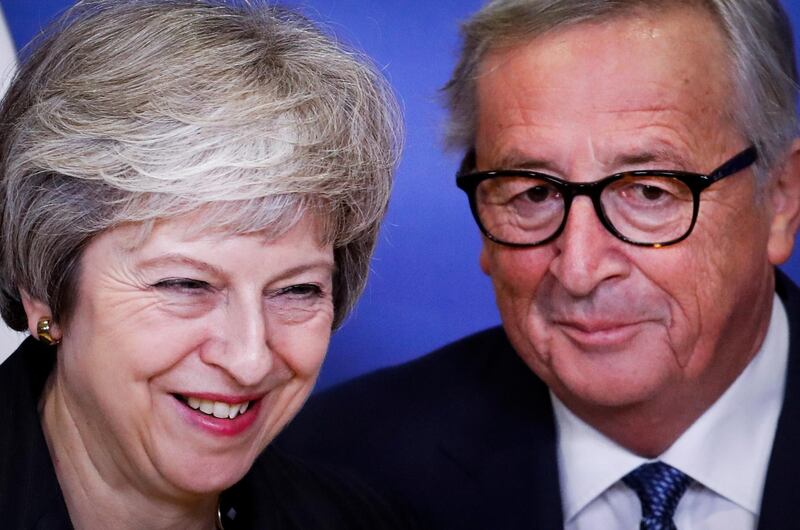Prime minister Theresa May made a lightning trip to Brussels on Wednesday to lobby EU chief Jean-Claude Juncker, but left with a planned Brexit deal signing summit still in the balance.
With less than four days until Sunday’s meeting, a European Commission spokesperson said: “Very good progress was made in meeting between President Juncker and Prime Minister Theresa May.”
But she added: “Work is continuing.”
Negotiators are hammering out details of a political statement on future UK-EU ties that will accompany the divorce deal, under pressure to put it together before member states’ top diplomats meet on Friday.
_______________
Read more:
Brexit deal works for all UK, Theresa May tells Scottish leader
May gets rebellion reprieve, but faces warning from allies
_______________
After enduring another parliamentary grilling at prime minister’s questions in London, the British leader slipped out of the Westminster bear pit and crossed the Channel to meet the head of the EU executive.
Having seen off – at least for now – a potential leadership challenge by hardline Brexiteers in her own party, she hoped to wring out of Brussels a Brexit arrangement that she can sell to her parliament.
The withdrawal treaty itself is all but final, and preparations are underway for Sunday’s summit to sign it, but there remains the matter of the parallel 20-page political declaration on future relations.
European diplomats and EU officials have been in intense talks on the declaration this week. One of them told AFP that they now expect to publish it on Thursday morning, after Mrs May’s afternoon tea with Mr Juncker.
Neither side has much wiggle room left to polish the text, but Mrs May must show that she has left nothing on the table if she is to convince British members of parliament to ratify the deal in the coming weeks.
Mrs May and Mr Juncker were expected to cover fishing rights and the movement of goods after Brexit, as well as the duration of the transition period and the British territory of Gibraltar, which lies on an outcrop off Spain.
She faces pressure from her Northern Irish allies, who oppose a deal they say weakens British sovereignty in their province, and from Spain, which warned it might oppose the accord over Gibraltar.
Madrid wants a veto over applying any agreement on post-transition relations to Gibraltar, but Mrs May told MPs that Britain “will not exclude Gibraltar from our negotiations on the future relationship”.
There is frustration among some EU countries at Spain trying to play hardball so late in the game.
“We are following the latest developments with growing concern and incomprehension – among the EU27 our Spanish friends are all alone on this,” an EU diplomat told AFP.
Two of Mrs May’s top ministers quit last week, including her Brexit secretary, while MPs from all parties came out against the withdrawal deal – increasing the chances that Britain will crash out of the Union on March 29 without an agreement.
A minister who opposed Brexit and who returned to Mrs May’s cabinet in a reshuffle triggered by the resignations, tried to rule out this economically disruptive scenario.
“It is my view that the parliament, the House of Commons, will stop no deal ... There isn’t a majority in the House of Commons to allow that to take place,” Work and Pensions Secretary Amber Rudd told BBC radio.
The withdrawal deal covers Britain’s financial settlement, expatriate citizens’ rights, contingency plans to keep open the Irish border and the terms of a post-Brexit transition.
Officials are now racing to agree the accompanying outline statement on the future trading and security relationship for after Britain leaves the EU’s single market and customs union in March.
Opposition to the agreement is also building in the pro-Brexit camp.
On Monday, MPs from Northern Ireland’s Democratic Unionist Party (DUP) abstained on three budget votes in the Commons and voted against a fourth, despite their deal to back the government on finance matters.
Anti-Europe Conservatives have also savaged the divorce deal, which they say keeps Britain too close to the EU.
Rebels led by MP Jacob Rees-Mogg failed in their attempt to force an immediate confidence vote in Mrs May’s leadership, but warned they would keep trying.
The withdrawal agreement sets out plans for a 21-month transition after Brexit, in which Britain and the EU want to turn their outline agreement on the future relationship into a full trade deal.
But controversially, it says that if that deal is not agreed in time, Britain will adopt a “backstop” arrangement to keep open its land border with Ireland.
This would keep all of Britain in the EU’s customs union, and Northern Ireland also in parts of the single market.






